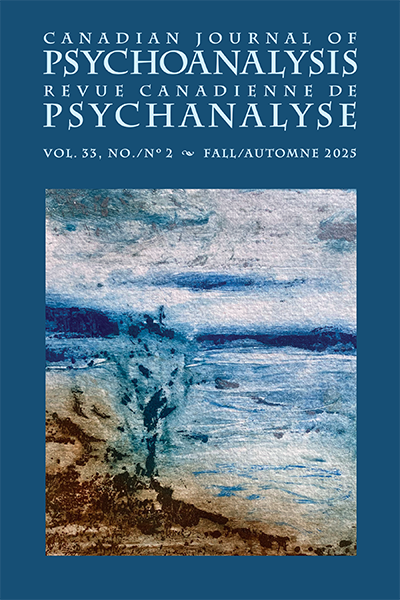Vol. 33, No. 2, Fall 2025
Contents
INTRODUCTION
Louis Brunet, Margaret Ann Fitzpatrick Hanly, Marie Claire Lanctôt Bélanger, Darren Thompson
Since its launch, the Canadian Journal of Psychoanalysis has sought to be a forum for exchange. Each issue of the Journal publishes contributions from international authors representing European, British, and American schools of psychoanalysis. But the Journal is also a forum for exchange between Canadian psychoanalysts a mari usque ad mare through the bilingual nature of the Canadian Psychoanalytic Society.
Read the rest (Download the introduction in PDF)
ARTICLES
Reflections on Psychoanalytic Supervision: Learning with Ron Brown
Michelle Kwintner
There are many papers written about supervision but few about the experiences of the supervisee. This paper describes the author’s time learning in supervision with the late Dr. Ron Brown. It names some features of supervision that keep the learning space open and elements of the supervisory process that may lead to a collapse of that learning space. Inspired by the ideas of Hanoch Yerushalmi on the supervisee’s unique experiential knowledge, the paper examines the inevitable Oedipal dynamics embedded in the triadic configuration of patient, analyst, and supervisor.
Keywords: supervision, training, unformulated experience, Oedipus, Hans Loewald, Ron Brown
Salvador Dalí, l’enfant réincarné et la difficulté à se constituer un corps unifié
Simon Dureuil
In this article, I look at the consequences of a birth following the death of an older sibling, inscribing the newborn as a “reincarnated child,” carrier of the necronym. I base my analysis on the painter Salvador Dalí’s writings. First, I show the specific features of the notion of the reincarnated child, a particular form of the replacement child. Then, I refer to various “autobiographical” elements in Dalí’s writings, revealing the omnipresence of the double and the difficulty of corporeal integration. Then, through a few paintings, I show the manifestation of the brother-double. In addition, I examine the effects of Dalí’s necronym, which freezes him in a closed meaning, preventing him from differentiating himself from the dead and leading to sexual difficulties. Finally, I highlight the way he uses his wife Gala as a suppléance (i.e., a subjective construction produced by the subject to avoid psychic collapse) to protect him from the parasitic dead brother.
Keywords: Salvador Dalí, replacement child, body, creativity, suppléance
Des racines (sexuelles) à l’écriture de cas
Jean-Yves Tamet
Perception of the sexual in the psychoanalytic sense is not direct: it involves variations awakened in the reader which therefore follow a hesitant, non-linear path. The article offers perspectives that highlight this presence, ranging from written case studies to other more literary and poetic works. Freud’s close association with authors runs between the lines like a common thread.
Keywords: clinical writing, sexual, notes, death drive, literature
Suicide and Its Discontents: “Essential Aloneness”
Arthur Leonoff
The author explores the genesis of a particular form of longstanding suicidality, finding its roots at the beginning of life. Following Winnicott’s theory of “essential aloneness” as a pre-object relational state associated with a primal state of peaceful quiescence, it is proposed that some suicidal subjects may lack this developmental capacity in part or in full. They can find no sanctuary from psychic pain. It is primitive agony without respite for which “unaliveness” is deemed a triumph over suffering. One finds a regressive wish to recover essential aloneness and not necessarily a wish to permanently end one’s life. The short but well-chronicled life and death by suicide of poet Sylvia Plath, as well as a clinical case example, are both discussed in support of this hypothesis.
Keywords: suicide, essential aloneness, Winnicott, Sylvia Plath, schizoid
Une revendication indomptable ?
André Beetschen
The social exposure of sexualities has radically increased with the proliferation of sociological studies and personal accounts, bringing about widespread displays of intimate details and the demand for jouissance and immediate satisfaction. If psychoanalytic practice cannot ignore this development, how does it nevertheless continue to explore the enigma of instinctual claims and their possible treatment through transferential experience given the pains of sexual life? Unseen forces, unconscious destinies, infantile determinism and transformations of instincts remain on the agenda. As sexual and death instincts set the stage, the compulsion to repeat gets admixed with the sexual plasticity of eroticism. Taking into account the second theory of instincts opens up the exploration of an addictive, traumatic and sometimes destructive part of sexual life where defusion of instincts, the pain of inaccomplishment, and masochism can prevail. How do we transform them so that they become part of psychic life?
Keywords: life instinct, present, dual instinct, narcissism, superego
Second regard sur le rêve de commodité
François Sirois
Dreams of convenience in adults are more complex than those of children as they contain material which is derived from psychical sources over and above those stemming from bodily needs or external necessity. As “dreams from above,” they are associated with a significant day residue which is described. Discussion of a vignette opens up the issue of representation of dream thoughts and the utility of such dreams to soothe the bruising of psychic equanimity.
Keywords: dream of convenience, dream-instigator, dramatization, representation
REVIEWS
Philippe Forest : rêver pour traverser la perte
Et personne ne sait by Philippe Forest
Reviewed by Marie Claire Lanctôt Bélanger
Devenirs trans de l’analyste by Nicolas Evzonas
Reviewed by Martina Burdet Dombald
Why Ferenczi? The Empathic Style in Psychoanalysis by Daniel Kupermann
Reviewed by Endre Koritar
Download the Table of Contents (PDF)
Previous Issues
Vol. 33, No. 1, Spring 2025
(Download table of contents PDF)
Vol. 32, No. 2, Fall 2024
(Download table of contents PDF)
Vol. 32, No. 1, Spring 2024
(Download table of contents PDF)
Vol. 31, No. 2, Fall 2023
(Download table of contents PDF)
Vol. 31, No. 1, Spring 2023
(Download table of contents PDF)
Vol. 30, No. 2, Fall 2022
(Download table of contents PDF)
Vol. 30, No. 1, Spring 2022
(Download table of contents PDF)
Vol. 29, No. 2, Fall 2021
(Download table of contents PDF)
Vol. 29, No. 1, Spring 2021
(Download table of contents PDF)



